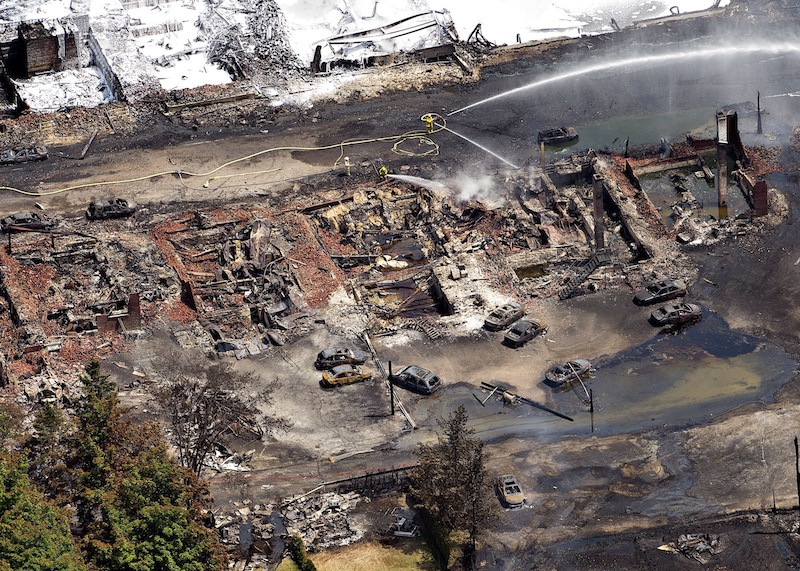WASHINGTON (AP) — Federal inspection teams have been conducting spot safety checks of rail shipments of crude oil from the booming Bakken oil region in Great Plains states in response to last month’s rail disaster in Canada, U.S. officials said Thursday.
The official name of the inspections is “Operation Classification,” although Cynthia Quarterman, head of the Pipeline and Hazardous Materials Safety Administration, said she prefers to call them the “Bakken Blitz.” They are being carried out jointly with the Federal Railroad Administration and began last weekend, although they weren’t publicly disclosed until Thursday.
Last month, an unattended train carrying oil from the Bakken region came loose and derailed, sending tank cars hurtling into the center of the lakeside Quebec town of Lac-Megantic near the Maine border. Several cars exploded, killing 47 people and destroying much of the town.
Officials said they were surprised by the disaster because they thought the type of oil being transported was unlikely to ignite.
Safety regulations for the transport of crude oil differ depending upon the type of oil and its flashpoint — the lowest temperature at which it will ignite, Quarterman said. Inspectors want to determine whether the quality of the oil being shipped “is what the shipping papers say it is,” said Quarterman, who spoke to reporters at an emergency rail safety advisory committee meeting.
“For example, they should have a safety and security plan if they are shipping something that is very volatile,” she said. Such a plan might include keeping someone with the train at all times rather than leaving it unattended, she said.
Joseph Szabo, head of the railroad administration, said the Lac-Megantic explosion was “very unusual for crude.”
“Generally speaking, these grades of crude would not be that volatile,” he said.
The Bakken region is a rock formation underlying portions of Montana and North Dakota in the U.S., and Saskatchewan and Manitoba in Canada.
In the first half of this year, U.S. railroads moved 178,000 carloads of crude oil. That’s double the number during the same period last year and 33 times more than during the same period in 2009. The Railway Association of Canada estimates that as many as 140,000 carloads of crude oil will be shipped on Canada’s tracks this year, up from 500 carloads in 2009.
Much of that increase is from oil produced in the Bakken region. The train that crashed in Quebec was carrying oil from North Dakota to a refinery in New Brunswick, Canada.
The committee meeting at which Quarterman and Szabo spoke was called to consider safety issues raised by the Lac-Megantic disaster. The explosions leveled the town’s center, affecting 125 businesses that employed many to the town’s approximately 6,000 residents. About 2,000 people were evacuated.
Quarterman said her agency expects within the next few days or weeks to publish draft regulations requiring a type of rail car known as the DOT-111 be retrofitted to address safety concerns. She indicated her agency had completed work on the proposal but was awaiting approval from the White House Office of Management and Budget, which analyzes the economic costs of regulations versus their safety benefits.
The agency’s proposal is intended to fix a dangerous design flaw in the rail cars, which are used not only to haul oil, but also other hazardous liquids from coast to coast. The soda-can shaped car has come under scrutiny from safety experts because of its tendency to split open during derailments and other major accidents. Defects in the car’s structure were noted as far back as 1991.
Another key issue is whether railroads should be required to employ a minimum of two workers per train. The train that exploded, which included 72 cars of crude oil as well as the locomotive and other cars, had only one engineer, who wasn’t with the train at the time of the accident.
The railroad administration issued an emergency order after the accident requiring railroads take a number of safety actions but stopped short of requiring a minimum of two-man crews on trains. Mike Rush, an American Association of Railroads attorney, told the committee that safety data doesn’t support the need for new regulations requiring two-man crews.
Federal officials said they believe most major U.S. freight railroads already use at least two-member crews on their trains. However, some short-line railroads use only one-man crews, they said. Rather than rush to create new regulations, officials said they want to look into whether a two-member crew requirement makes sense for trains that move only a few cars a short distance at slow speeds.
Szabo said he wants to take a more “nuanced” look at the issue “rather than try to force a one-size fits all approach on all railroad operations.”
___
Follow Joan Lowy on Twitter at http://www.twitter.com/AP_Joan_Lowy
Copyright 2013 The Associated Press. All rights reserved. This material may not be published, broadcast, rewritten or redistributed.






